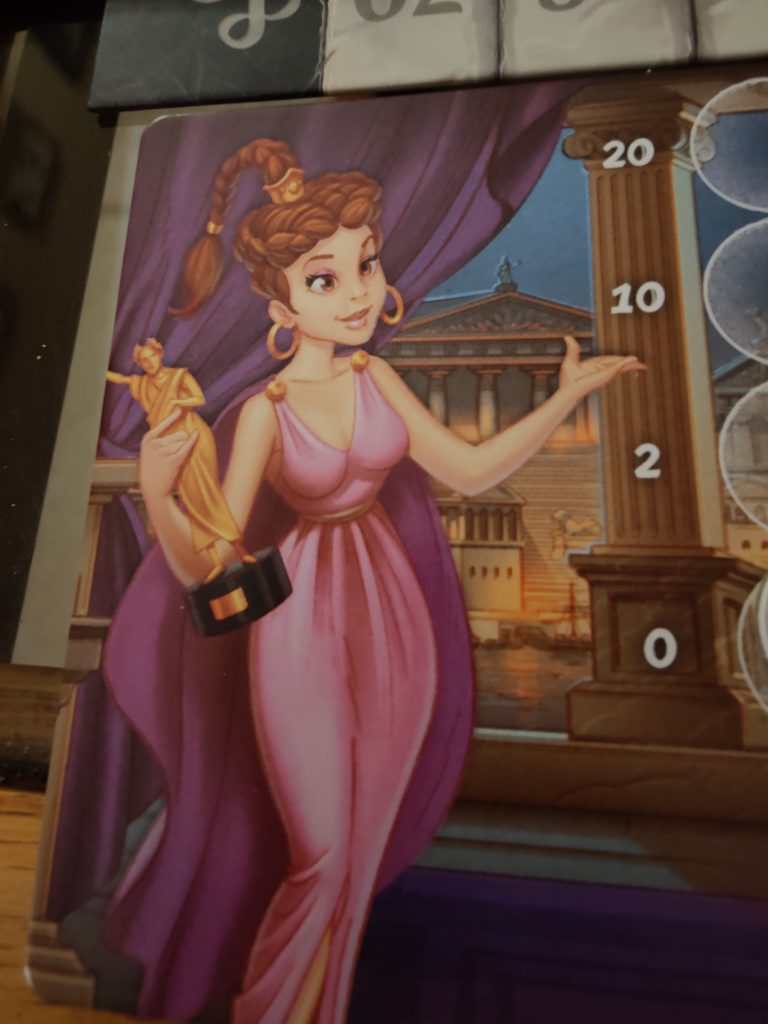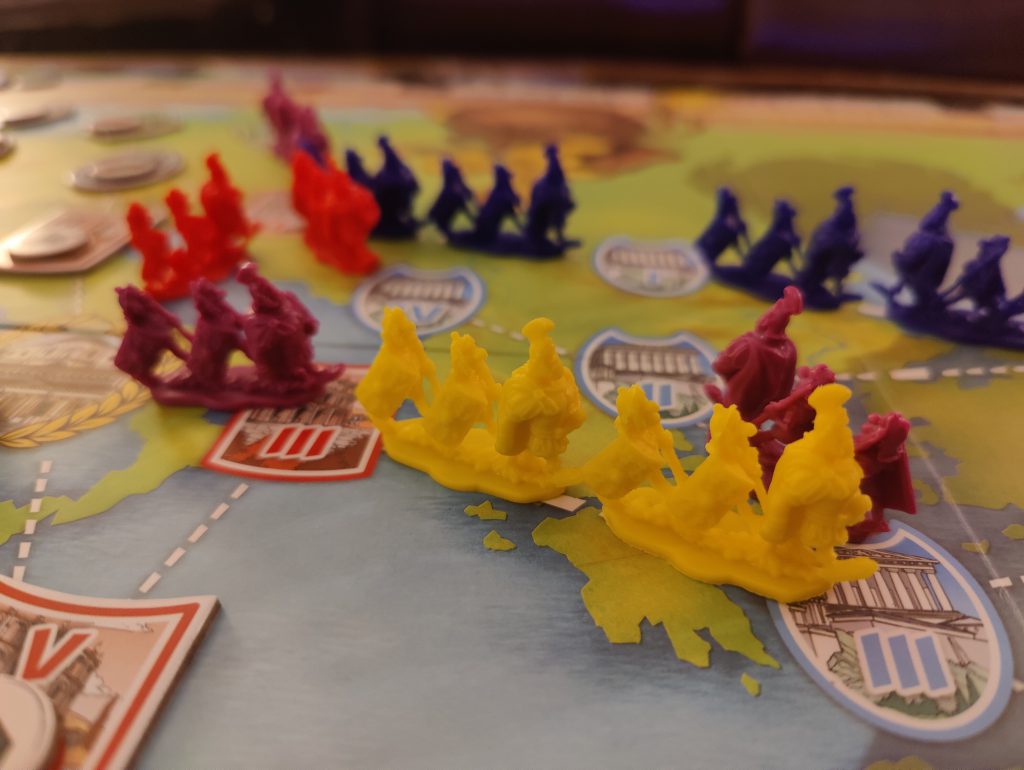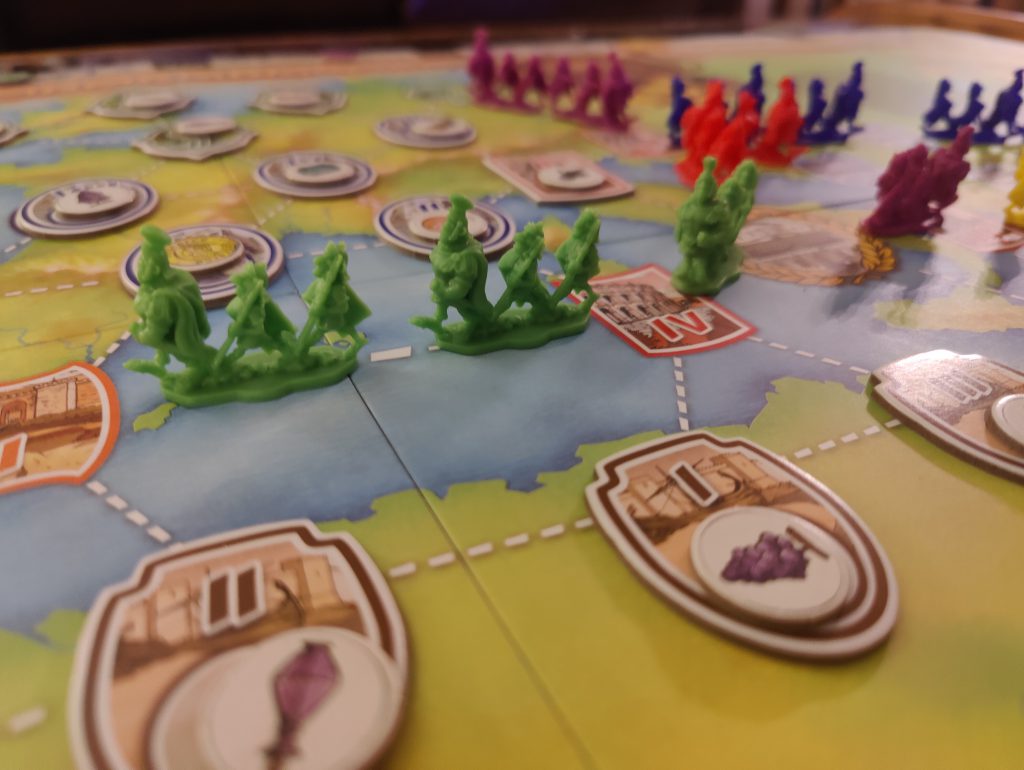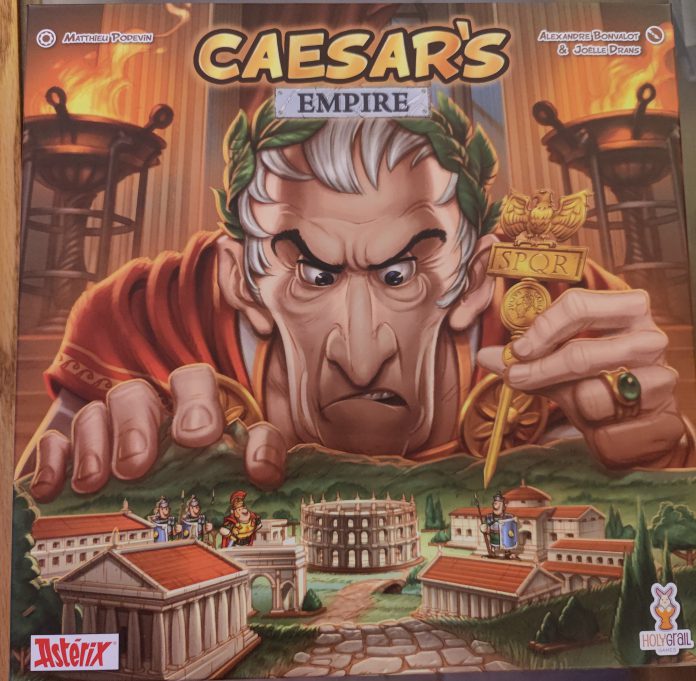Ancient Rome is one of my favorite periods of history, and is a surefire way to make me interested in any product you’re producing. I actually own more games set in ancient Rome than I do any other setting, without getting technical about ‘sci-fi’ or ‘fantasy’. I’m also an avid fan of comics, having grown up reading them and spending a huge chunk of my personal career path writing about and studying graphic fiction from across the globe, so I’ve always had a special place in my heart for Asterix, the French comics by René Goscinny and Albert Uderzo (with the caveat beforehand that yes, quite a lot of these comics have aged very poorly, for anyone who is about to ask). I was honestly shocked that there are so few Asterix themed board games, and even doubly shocked by the sudden appearance of Caesar’s Empire from designer Matthieu Podevin and published by Holy Grail Games, two names I have honestly never heard of before. But, sure enough, while browsing new game releases I saw the iconic face of Goscinny and Uderzo’s rendition of Caesar, staring down at a map, with the “Asterix” logo in the bottom corner of the box.
I had to play it. Even if it was bad, I had to know. I had enjoyed the comics and Rome too much to pass on it, so I immediately ordered a copy, and found one of the most fun, but thematically perplexing, games I’ve ever encountered.

All Roads Do Actually Lead to Rome, It’s Not Just a Phase Mom!
Caesar’s Empire is a competitive route laying game for 2-5 players, and plays within an hour, even at 5. Yes, you read that correctly. This is a game that accommodates 5 players and is done within 60 minutes, give or take a few extra minutes on your first ever playthrough. The more you play it, the faster it can actually get, to the point that the game deserves a spot in most collections for that alone. The amount of games that are good at 5 AND don’t eat up an entire day of players time is probably less than most people have fingers, but Caesar’s Empire manages it. And best of all, the game is also fun, which probably is more important than playtime.
On a player’s turn, they place down their color of soldiers to build a road. All roads literally start from Rome, and players score based on the number of their color soldiers that lead back to Rome. Roads are not exclusive, so players can extend already established roads, meaning that ALL players in the line score points, counting from the newest laid piece back to Rome, with priority given to the “shortest” route in the case of multiple paths. And that’s literally it! Yes, I know, it almost sounds too simple. There’s no card playing, no dice, no direct conflict interaction, just select a destination, place your pieces, and then pick up the relevant City and Resource tile that your road leads to.
In our first play, my group of 4 players learned the game within two turns, and we finished a game within 45 minutes, record time for a literally brand new game for our group. The simplicity of Caesar’s Empire might seem potentially a negative, but the game is so fun, elegant, and efficient that it doesn’t overstay it’s welcome. Players have plenty of choice, and smaller number games (2-3) play on a smaller board, meaning that decision spaces are still tight and meaningful, and randomized set-up of the resource tokens means that no game will ever have the same distribution of the various scoring items. Playing a few rounds of Caesar’s Empire can be completed in half the time it might take to play medium-weight games, making it great filler, a game night opener or ender, or even an enticing gateway game for newer or inexperienced board game players, including children.

Aut Caesar, Aut Nihil
So, what problems, if any, plague this game? Frankly, I don’t have any with the mechanics. It is a beautifully simple and fun game. The miniature soldier ‘route’ tokens feel nice and look great on the board, with the final product of your session producing something quite impressive looking to anyone who might pass by your table. The game really comes to life and benefits from the bright colors and design elements. The map, too, has some great and fun little details: Caesar’s shadow looms over the entire board, with his sword laying at one side, upon which players can note the player count this side of the board is for. There’s even a small Asterix and Obelix, which… brings us to the problem.
This game has no “theme”, if the “theme” you want is Asterix.

That’s right: the titular character of the storied comic makes no actual appearance in the game. There is no mechanic for Asterix and his friend Obelix showing up and meddling with Caesar’s plans, and players actually assume the role of semi-infamous Asterix villains, all of whom are working to be the most impressive road-builder for Caesar’s empire. Even that, though, has no particular flavor or thematic element: Brutus doesn’t do anything cunning, La Traviata doesn’t make use of her acting and espionage skills, Cassius Ceramix doesn’t show off his impressive strength or mix of cowardice and ambition–basically, the characters don’t matter other than helping to denote colors on the board. Also, sorry to people who like Blue, because you’re stuck with Varius Flavus (I will at least say that I appreciate the game included one female option, especially since Asterix has very few women in general!). But, yes, the colorful character boards, full character art and names in the rulebook translate to… nothing, really.

As far as I am aware, the game is based on a previous game, also called “Roads to Rome”, so it appears that the aesthetics of Asterix were applied afterwards. From checking out Roads to Rome on BGG, I noticed that it is quite literally the same game, down to the layout of the map, style of tokens, and basic systems of the game, so the application of the Asterix theme and rebranding of it as “Caesar’s Empire” seems… odd, really. The cynic in me says that it was mostly to make the game more marketable and to stand out, which I can’t argue with, because I quite literally bought the game because of that Asterix logo and art on the box. The fact that the game ended up being very good is vindication, but if you are looking to buy this as the Goonhammer Asterix Superfan Reader, well, you at least get some cool art, but… nothing else. Perhaps if the game does well enough, there’ll be some form of expansion to bring some thematic elements or player powers into it, but frankly I’m fine with the game as it is, just confused by the thematic void.

The Anti-Meta Board Game, or: Filling Up on Appetizers
Lately, I have a hard time getting board games to the table. My regular play group has only met twice in the past 3 months, and most board games I do get to play are either non-interactive multiplayer solitaire affairs, or are complicated and get maybe one play, protracted over hours, as players pour over rules or want clarifications. These are all fine, but it makes game sessions exhausting and sometimes not worth the hassle. Caesar’s Empire is a magical thing: I set it on the table, got it played under the estimated time, and everyone not only enjoyed the game, but knew how to play it and wanted to play it again. It looks amazing, with the miniatures all sprawled over the map, and the simplicity makes it almost a magical unicorn in terms of game design these days. The rulebook, if it can be called that, is a fold-out pamphlet, and answers every question one could have with solid clarity. The only confusing aspect with the game was establishing when you lay 2 route tiles versus just one, but even that made sense after the second turn of the game.

Most importantly, Caesar’s Empire serves as an amazing gateway game. It requires very little explanation, players of all skill-level can easily enjoy it, and the game doesn’t overstay its welcome in a way that someone unfamiliar with or new to board gaming might find tedious. Horror stories of new players being roped into things like 5 player Wingspan because it is a “gateway” game makes the elegant design here worth noting. Of course, the game does not have the mechanical depth of a game like Wingspan, but that’s fine. Honestly, I find that almost refreshing, as even games sold in big box stores such as Target are beginning to tilt towards more complicated, more heavy affairs. Caesar’s Empire reminds me quite a bit of Ticket to Ride, but oddly easier to play and more fun to boot.

Of course, I’m still sad that the thematic element of Asterix is basically candy-coating. It certainly helps the game look nice, but it has no impact on gameplay, and makes me feel… weird. I love it, but I also don’t. The game, though, I love. I highly recommend it, and as we tend towards the holidays and colder months where spending time indoors might be more common, I cannot recommend Caesar’s Empire enough for almost any collection: Play it with your gaming group to break the ice, play it with your kids to get them into gaming without the hassle, play it with your parents who only remember suffering through Candyland and Monopoly with you as a kid.
Final Verdict:
Caesar’s Empire is vast, welcoming, and fun. Romans were fond of saying “Non licet omnibus adire Corinthum”, but you’re always welcome to go to Caesar’s Empire, and bring your 5th friend along.
Have any questions or feedback? Drop us a note in the comments below or email us at contact@goonhammer.com.


